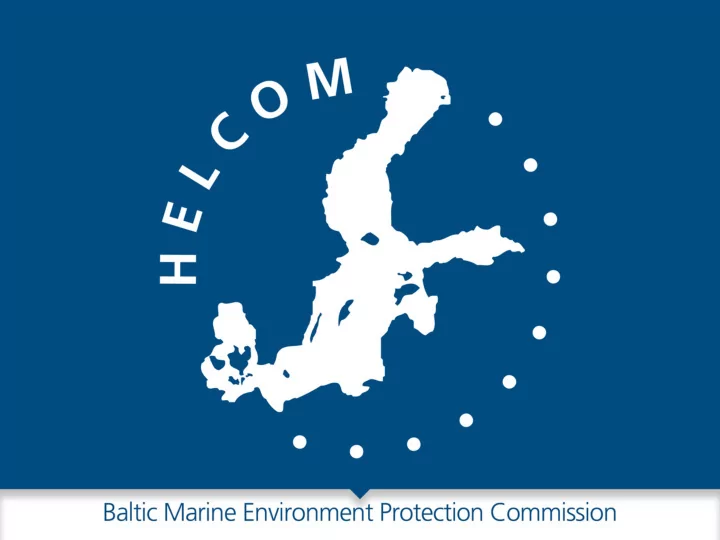

Use of the results of the SPICE project on marine litter Marta Ruiz HELCOM Secretariat HOLAS II 8-2017 Helsinki, Finland, 28-29 November 2017
Microlitter Report on information collected on microlitter. It includes a map showing where data is available and from where data is expected in the future, covering water column & water surface, seafloor sediment and strandline Amend the text to refer to the report and emphasise that research and pilot monitoring is very active at the moment in several countries and that it can be expected that after 1-2 years significantly more data will be available for assessing microlitter and microplastics in Baltic Sea environment. However, before this, there are several issues which need to be solved. Most importantly methods for both sampling and analyses must be harmonized and targeted for Baltic Sea specifically.
Litter on the seafloor Report on analysis of seafloor litter data from BITS trawling hauls 2012 2013 2014 2015 2016 DK 144 140 90 112 96 EE 9 10 DE 51 104 115 107 118 LV 14 44 LT 4 8 PO 31 100 SE 82 75 74 78 78
Litter on the seafloor Data from 1599 hauls were used. The data set contained samples from 9 sub • regions. Sampling frequency has increased over the years, from 257 reported hauls in 2012 • to 433 hauls in 2016. 42% of the hauls contained no items. • The average total number of items overall years was 58.9± 20.9 items per km 2 • (Average ± 95 confidence interval). The average total weight of items overall years was 85.3±65.2 kg per km2 (Average ± 95% confidence interval). There is no statistically significant trend of decreasing number of items per unit • area. However, this trend should be interpreted with caution, as the geographical scope of trawl hauls has changed during the period with the addition of hauls from the Gdansk Basin and the Northern Baltic Proper in 2015-2016. There is no statistically significant trend in the weight of items. The average number of items differed significantly among sub-basins, with the • Western Gotland Basin having significantly higher numbers than other basins.
Litter on the seafloor For weights, the tows from the Northern Baltic proper were significantly higher than • hauls from all other sub-regions. However, this analysis is based on the contents of only 9 hauls, and must therefore be interpreted with caution. There were no statistically significant differences among other sub-regions. The different sub regions showed different trends. Arkona basin and Eastern • Gotland basin show signs of a decreasing trend, but these trends are not statistically significant. Kiel Bay has a statistically significant increasing trend. Other areas show no clear tendencies of trends. Items made from natural materials is most common both in terms of number of • items (44.6%) and in terms of weight (56.6%). Plastic is the second most common material category (30.6% of number of items, 15.7% of the weight). The composition of litter differed significantly among sub-regions. While items • made from natural materials dominated in most regions, plastic items dominated in hauls from the Northern Baltic proper and the Gdansk basin, and metal items dominated in the Kiel bay.
Litter on the seafloor Proportion (%) of material categories in hauls in different sub regions (summed overall years). No data on the number of items in different categories was available from hauls in the Great belt sub region.
Litter on the seafloor The 15 most common types of items (in terms of number and weight) found in trawl hauls for all 9 sub-regions combined.
Beach litter N. Frequency Country Monitoring ML items monitoring monitoring per period categorization Report on the analysis of compiled data sites year on beach litter in the Baltic Sea area 2015 - TG ML DK 3 3(4) 2016 Master list Calculations done by type of beach and 2012 - MARLIN/ material for: EE 10 3 2016 UNEP/IOC (i) 2012-2016: DE, EE, FI, LV, LI and SE 2012 - MARLIN/ FI 12 3 2016 UNEP started beach monitoring in 2012 2012 - OSPAR, with (ii) 2015-2016: since 2015 monitoring is DE 26 4 2016 slight adaptations carried out in all countries (except LI and RU) and since this year, the 2012 - MARLIN/ LV 42 1 2016 UNEP network of monitoring stations has expanded 2012 - LT 4 4 2013 2015 - TG ML PO 15 4 2016 Master list 2012 - MARLIN/ SE 10 3 2016 UNEP
Beach litter Period 2012-2016
Beach litter Period 2015-2016
Beach litter Regional top litter items by type of beach
Beach litter NEW: Sub-regional top litter items
Beach litter NEW: Sub-regional top litter items-> Highlights • Many of the items are related to eating, drinking and smoking activities • Pieces of plastic of different size and plastic bags are found at all sub- basin top litter item lists • Balloons and balloon related items can be found at 60% of sub-basin top litter item -lists • Industrial packaging related items such as sheeting, strapping bands and masking tape can be found at 73% of all sub-basins. • Derelict fishing gear can be found within the Eastern Gotland Bay, Gdansk Bay and Kiel Bay top litter item -lists. • The proportion of how much the top litter item –list counts of the total litter items varies from 64,92 to 100 %. The average proportion is 85,42 %.
Proposed way forward The Secretariat to provide a draft revised text of the marine litter section in update of ‘State of the Baltic Sea report, June 2017’ by 12 December 2017 to the HELCOM EN-Marine Litter and State & Conservation contacts for technical evaluation and quality assurance of the proposal by 1 February 2018
Thank you! Name 11/29/2017 Surname 16
Recommend
More recommend